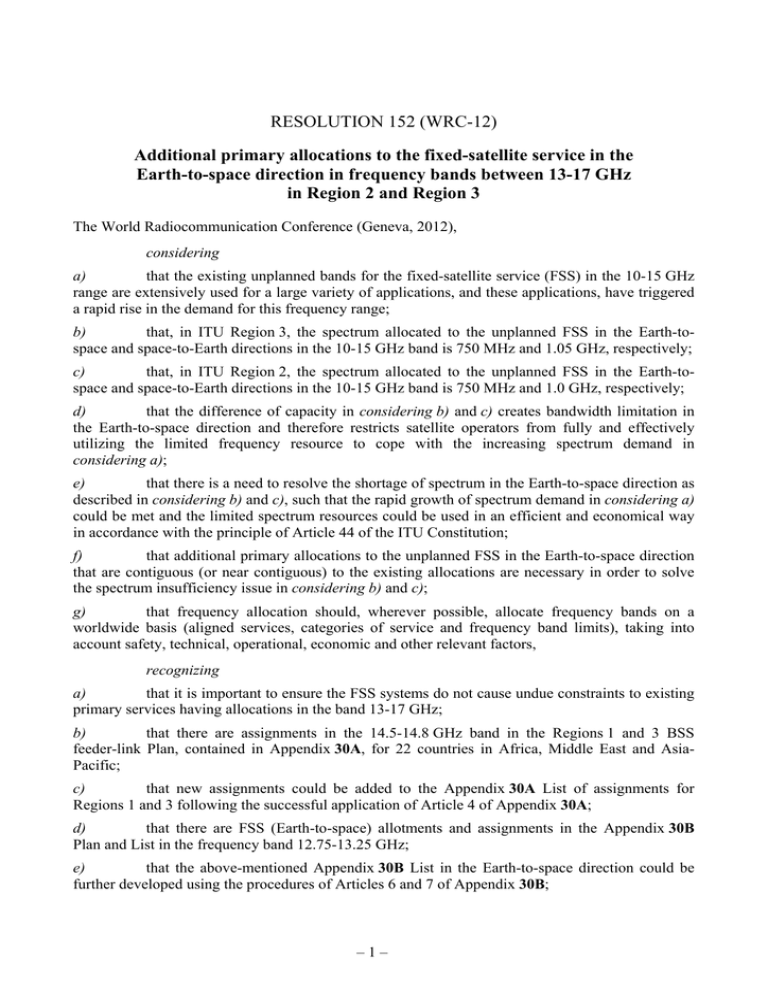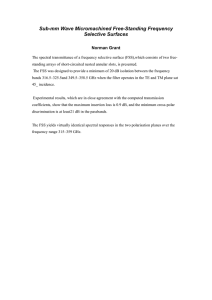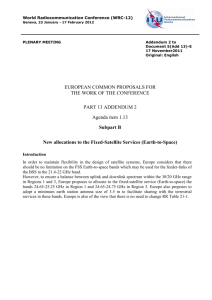RESOLUTION 152 (WRC-12) Earth-to-space direction in frequency bands between 13-17 GHz
advertisement

RESOLUTION 152 (WRC-12) Additional primary allocations to the fixed-satellite service in the Earth-to-space direction in frequency bands between 13-17 GHz in Region 2 and Region 3 The World Radiocommunication Conference (Geneva, 2012), considering a) that the existing unplanned bands for the fixed-satellite service (FSS) in the 10-15 GHz range are extensively used for a large variety of applications, and these applications, have triggered a rapid rise in the demand for this frequency range; b) that, in ITU Region 3, the spectrum allocated to the unplanned FSS in the Earth-tospace and space-to-Earth directions in the 10-15 GHz band is 750 MHz and 1.05 GHz, respectively; c) that, in ITU Region 2, the spectrum allocated to the unplanned FSS in the Earth-tospace and space-to-Earth directions in the 10-15 GHz band is 750 MHz and 1.0 GHz, respectively; d) that the difference of capacity in considering b) and c) creates bandwidth limitation in the Earth-to-space direction and therefore restricts satellite operators from fully and effectively utilizing the limited frequency resource to cope with the increasing spectrum demand in considering a); e) that there is a need to resolve the shortage of spectrum in the Earth-to-space direction as described in considering b) and c), such that the rapid growth of spectrum demand in considering a) could be met and the limited spectrum resources could be used in an efficient and economical way in accordance with the principle of Article 44 of the ITU Constitution; f) that additional primary allocations to the unplanned FSS in the Earth-to-space direction that are contiguous (or near contiguous) to the existing allocations are necessary in order to solve the spectrum insufficiency issue in considering b) and c); g) that frequency allocation should, wherever possible, allocate frequency bands on a worldwide basis (aligned services, categories of service and frequency band limits), taking into account safety, technical, operational, economic and other relevant factors, recognizing a) that it is important to ensure the FSS systems do not cause undue constraints to existing primary services having allocations in the band 13-17 GHz; b) that there are assignments in the 14.5-14.8 GHz band in the Regions 1 and 3 BSS feeder-link Plan, contained in Appendix 30A, for 22 countries in Africa, Middle East and AsiaPacific; c) that new assignments could be added to the Appendix 30A List of assignments for Regions 1 and 3 following the successful application of Article 4 of Appendix 30A; d) that there are FSS (Earth-to-space) allotments and assignments in the Appendix 30B Plan and List in the frequency band 12.75-13.25 GHz; e) that the above-mentioned Appendix 30B List in the Earth-to-space direction could be further developed using the procedures of Articles 6 and 7 of Appendix 30B; –1– f) that transmitting earth stations of these above-mentioned allotments or assignments in the Plans or Lists, as the case may be, could be located at any point within the service area of its associated satellite network, further recognizing a) that the 13.25-13.75 GHz band has been allocated to the Earth exploration-satellite service (active) on a primary basis; b) that EESS (active) satellites with three types of active sensor in 13.25-13.75 GHz – scatterometers, altimeters and precipitation radars – have been operating in this band for many years. The remote sensing systems of EESS (active) are used in backscatter echomode to monitor weather, water and climate change and similar emergencies, with the aim of preventing natural disasters, which could suffer from interference resulting from FSS (uplink); c) that, although EESS (active) satellites are currently operated by only a limited number of countries, measurements are performed worldwide and the remote sensing data and related analyses are distributed and used globally, and are performed for the benefit of the whole international community; d) that the EESS (active) systems are crucial for the protection of human life and natural resources. It is necessary to ensure that the EESS (active) systems shall be protected without any undue constraints to their operations in the 13.25-13.75 GHz band; e) that the 15.35-15.4 GHz band, in which No. 5.340 applies, is allocated to Earth exploration-satellite (passive), space research (passive) and radio astronomy services; f) that the 13.75-14 GHz band is allocated to the fixed-satellite service and the radiolocation service on a primary basis, that the Earth exploration-satellite (passive), space research (passive) and standard frequency and time signal-satellite (Earth-to-space) services are allocated on a secondary basis, and that Nos. 5.502 and 5.503 and Resolution 144 (Rev.WRC-07) apply in this band, resolves 1 i) ii) to complete, for WRC-15: studies of possible bands for a new primary allocation to the fixed-satellite service in the Earth-to-space direction of 250 MHz in Region 2 and 300 MHz in Region 3 within the bands 13-17 GHz, with particular focus on the frequency range that is contiguous (or near contiguous) to the existing fixed-satellite service allocations, taking into account sharing and compatibility studies, while protecting the existing primary services in the band(s); studies that include consideration of utilizing existing allocations to the fixed-satellite service in the Earth-to-space direction through a review of regulatory provisions, except for Nos. 5.502 and 5.503 and Resolution 144 (Rev.WRC-07), taking into account sharing and compatibility studies, while protecting the existing primary services in the band(s); 2 that if consideration is given to use of the 14.5-14.8 GHz band, appropriate measures need to be taken with regard to the Appendix 30A Plan and List, as the case may be, to ensure the integrity and full protection of these bands, specifically taking into account: i) required coordination procedures between Appendix 30A networks, as the case may be, and the new fixed-satellite service utilization of the bands; –2– ii) iii) the need for transmitting earth stations in the Appendix 30A Plan and List to be able to be located anywhere within their respective service areas; the need to appropriately protect assignments in the Appendix 30A Plan and List, as the case may be, from any new fixed-satellite service utilization of the bands; 3 that the 13-13.25 GHz band shall be excluded from the studies referred to in this Resolution; 4 that WRC-15 consider the results of the above studies and take appropriate action, invites ITU-R 1 to conduct studies, as a matter of urgency, on technical (including necessary calculations and criteria), operational and regulatory issues on this topic, taking into account resolves 1, 2, 3 and 4, in time for WRC-15 to consider the results of these studies and take appropriate action; 2 to consider appropriate measures regarding the use of provisional recording in respect of coordination between assignments in the Appendix 30A Plan and List in the band 14.5-14.8 GHz and the new fixed-satellite service utilization, invites administrations to participate actively in these studies by submitting contributions to ITU-R. –3–


